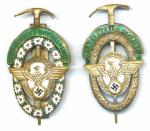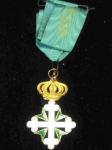-
Posts
102 -
Joined
-
Last visited
Content Type
Profiles
Forums
Blogs
Gallery
Events
Store
Everything posted by JoeW
-

1943 Water/Harbour Police
JoeW replied to Ben's topic in Germany: Third Reich: Uniforms, Headwear, Insignia & Equipment
Ben, a very nice buckle. Looks to be the mate of mine. But it was also used by the Verkehrspolizei (Traffic Police) and the color of their leather equipment was brown. So, possibly yours like mine was issued to a Traffic cop and got attached to a KM belt by someone thinking of the gold=KM connection? On the other hand, it might have been issued to a water police NCO who was transfered in from the KM and brought his belt with him. I have another steel CTD buckle like these, but it has no tab. Another I have is aluminum and dated 1940. It has a brown tab. -
The machete was used by flight crews in the frozen tundra too. At least that was the gist of the "Signal" magazine article showing the use of one of them. The "Signal" photo was published in Tom Johnson's volume III or IV if I remember correctly. Some of them were LW accepted and some had only commercial markings. The canvas frog as shown on yours was pictured another of Johnson's volumes. I have seen a leather frog too.
-
Yours are early examples of the Police Sport Insignia adopted in 1935. The eagle and wreath look odd because it is the early 1934 police eagle (thin eagle clutching a swaz surmounting a laurel wreath) as opposed to the more common post 1936 police eagle (fatter eagle facing to the left surmounting an oakleaf with swaz at 6 o'clock). The blue color indicated all police branches (Schupo, Gendarmerie, Gemeidepol.) except the Landespolizei that used a green eagle. Another Police Sport Insignia was designed using the second style eagle and it was always green.
-

Gendarmerie Abzeichen
JoeW replied to Thierry's topic in Germany: Third Reich: Uniforms, Headwear, Insignia & Equipment
attachment=112446:GendAlp_...hAlpObv1.jpg] Sorry, I believe your Alpinist Abzeichen is a modern repro. It bears no resemblance to the construction of original Austrian Alpinist and HochAlpinist badges on which the German police insignia was added. It appears brand new with no wear whatever for a badge made almost 70 years ago. Here is a view of the front of the two badges converted for wear by German police. The original small Austrian Wappen was incorporated into the ice pick shaft, not in the massive manner of yours. The simple police insignia was simply attached to the Austrian Wappen, not riveted to the entire badge. The method of attachment was a thin clip arrangement that the Germans often replaced with a military style pin. The eagle insignia itself is a poor reprodcution. These badges were first shown in the Littlejohn/Dodkins book from the 1970s. -
Clejuso advertised these cuffs quite a bit in police publications before and during the war. They were also available through other retailers like Akah and Geco from the early through the late 1930s as seen in their catalogs. Those sold by Geco were nickel plated in 1937. I would suggest that yours are older. The police were expected to use theirs for at least ten years before replacement. How do they wear out?
-
An article I wrote titled "Police Sport Championships and the Allach Police Presentation Plates" was recently published in Bender's magazine "The Military Historian" (Volume 18, Nr.3). Unfortunately the printer apparently had something against me and left my name off the article title page. But they managed to include it in the Table of Contents. I acquired a personal grouping of a police sport competitor and the material was of interest to me, so I found some source material and photos to provide some history of these items. Here is the link to the publisher site is anyone is interested in the article. http://www.bender-publishing.com/Home.html
-

Fake ID tags ?
JoeW replied to FireMedals's topic in Germany: Third Reich: Uniforms, Headwear, Insignia & Equipment
This disc design was identified as in use by the city police of Pforzheim from 1953-1959. before the state police assumed Kripo responsibilities. The disc was reproduced a number of years ago but that repro design differs from yours in a couple of points. It is possible that yours is original, but a final determination is really impossible from photos. -

Fake ID tags ?
JoeW replied to FireMedals's topic in Germany: Third Reich: Uniforms, Headwear, Insignia & Equipment
Item 1 appears to be a repro casting of a State Kripo Dienstmarke. Originals had the hole at the opposite end and featured a raised line above which the issue number was stamped. Item 2 appears to be a Dutch or Danish police Dienstmarke of some type. I don't know any more. Item 3 would be a post WWII German police Kripo identity disc for that city. I am not proficient on post war pieces so I have asked an expert friend in Germany. Item 4 is a post WWII badge for the police in Schwarzenbach a.d. Saale operating under the Military Government. These badges were worn both on US style police caps and on the tunic. It is a nice piece. If you don't care to keep it, I would like to buy it. -

Italy - Orders, Decorations and Medals
JoeW replied to Hendrik's topic in Southern European & Balkan States
These are two examples of his ribbon bars portraying receipt of these Italian orders. The top bar predated his award of the 10 and 15 year party long service in early 1940 that is shown in the lower bar. Is this Sts.M & L award the Commander grade? Thanks for your assistance. -

Italy - Orders, Decorations and Medals
JoeW replied to Hendrik's topic in Southern European & Balkan States
I have to modify these photos of the neck award and breast star, plus the officer's ribbon bar. They are too large a format for this platform. The officer received them in about 1938/39. They suffered damage but survived the war. He didn't. -

Italy - Orders, Decorations and Medals
JoeW replied to Hendrik's topic in Southern European & Balkan States
I will get my camera out an do that Jacky, when I return from the SOS. From Rich A. page he provided, it seems to be the second from the top, with the neck order and the four pointed star. But I cannot make out the page information as the picture is out of focus. -
Bob, I found the same thing in the file for a 73,xxx range party member from Thuringia whose pair of GPBs and Thuringen Ehren Adler I bought back in the happy days of Ebay. He had a propensity for loosing his badges and kept ordering new ones through the Gau Thuringen Treasurer's Office. So Kunstmann's tunic was originally configured to take the large GPB with a brooch pin, then the slot was added for the stud configuration. Great information.
-
Bob, I guestimated that to be the approximate width, judging from the EKI positioned on the tunic below the loops. The width looked to be equivalent to the raised EK outline width on the face of the EKI. So you think Kunstmann was dissatisfied with the floppiness of a 30mm badge that has the brooch style pin mounted on the upper half of the badge and would be prone to flopping because the center of gravity is below the axis of the pin. And to correct this he had the special slot made for a stud back arrangement. Seeing your tunic and hearing about the story of the badges, eliminates the necessity of having to explain my brooch pin by finding a suitable female recipient in the 30.1.43 list.
-

Italy - Orders, Decorations and Medals
JoeW replied to Hendrik's topic in Southern European & Balkan States
Rich, would you mind scanning or photoing the page on the orders of Sts. Lazarus and Maurice? I have a neck order and breast star and am trying to determine what grade they are. Thanks Joe -
I get the camera out this weekend Stan. I have posted already on another thread. I am curious about Bob's tunic pictured and the DAF tunic mentioned. I can not judge the size as there is not reference in the photo, but what is the distance between the two loops? My 30mm GPB has a brooch style pin that would require a maximum of 15-18mm distance between the loops.
-
I might add that my brooch pin-back A.H. GPB carries a 30.1.943 date. It is interesting that these late A.H. badges in cases were simply sent by registered post to the respective office (Gauleitung or Reichsleitung) for distribution to the nominated recipients. The Besitzurkunde were to follow later.
-
I thought I would bring this to the top to add my two cents. The Besitzrukunde is not necessary to properly associate the unnamed medal with the unnumbered Urkunde. I linked my second issue BO with the Urkunde that was sold with it on a Hermann Historica auction some years ago by locating the named recipient's party information card in the archives. That was marked indicating a BO was issued and the number. Bingo. And Rick, your deprecating comments as to the worthiness of all the "Dollfuss killer" Austrians and non-Putsch Germans who received the second issue BO should be tempered by the fact that some of those Austrians put everything on the line to advance that cause, however diseased its philosophy was. Not all of the first 1500 were fired upon by the Munich authorties were they? Some were left guarding the senior government officials taken prisoner or holding a strategic point, while Hitler lead the rest to the destiny. Some of the "unworthy" Austrians who received the second issue BO lost everthing and were forced to flee their homeland. The recipient of the second issue BO in my collection, Hans Dobek, was with the group that assaulted the Chancellor's office. While some participants were hanged, Dobek was sentenced to life in prison. Hitler negotiated with Schussnig the release of these men before the Anschluss. I think their efforts were just as worthy of the Blood Order as those of the 1500 who weren't fired upon. Perhaps they were equal in sacrifice to those before the Feldherrnhalle. Wasn't the above photo of Hitler wearing his BO taken during the internment ceremonies at the Ehrentempel on the Koenigsplatz?
-
Stan, this is certainly a fascinating history. You report that your documentation indicates Kunstmann exchanged two of the button-hole versions for "pin-back" versions. Did the documentation specify a brooch type "pin-back" or the military style "pin-back"? It is fairly obvious that the "pin-back" for Kunstmann was the broach style as evidenced by his tunic configuration in Bob's collection. The photo of Bob's tunic is is a bit of a relief to me as I have a 30mm A.H. Goldene Ehrenzeichen but with a brooch style. I assumed that anyone with a tunic would be provided an A.H. Badge with a military style pin. So I have been wondering who would have had a brooch style pin for a large badge. I thought that perhaps some senior BDM officials like Schlotz-Klink would have worn a 30mm badge with a brooch pin on their tunics. But now, I see evidence that a male recipient could choose a brooch style pin instead of the military style.
-

Porcelain SS Porzellan-manufaktur Allach
JoeW replied to J Temple-West's topic in Other Collectables
Hello, any Police plates out there? I'm trying to do a head-count for an article on which I am working.







